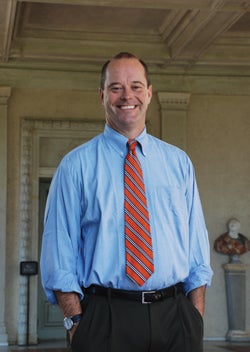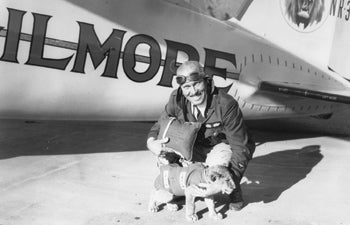Return to Camelot
Southern California: sunbeams, major motion picture companies, pricey real estate, Disneyland, and the aerospace industry. Even though it has greatly impacted the region since the early 20th century, aerospace has received comparatively little attention, especially of the scholarly kind. That is until now.
Bill Deverell, professor of history in USC College and director of the Huntington-USC Institute on California and the West, along with two key colleagues, is heading the mission for takeoff with the support of a National Science Foundation grant that is funding a postdoctoral researcher at USC and an archivist at The Huntington Library, Art Collections, and Botanical Gardens in Pasadena.
“We three amigos — Peter Westwick, an award-winning historian of science and technology; Dan Lewis, curator of history and science and head of manuscripts at The Huntington; and I possess complementary skill sets,” he said.
Deverell’s overarching charge as director of the institute is to develop new fields, train new scholars, work on collections and preservation, and popularize the issues that are being illuminated historically. The aerospace project is exemplary in meeting these criteria.

Bill Deverell, professor of history in USC College, directs the Huntington-USC Institute on California and the West. Photo credit Laurie Moore.
“I am thrilled by what I see when people’s lives are touched by personalized individual life stories, and I hear them proudly recount having worked on the aircraft shop floor, worked at Northrop for 35 years, or worked at Lockheed.”
It used to be easy to name the six big aerospace companies, but today it is challenging.
“People are unsettled by moves, consolidations and mergers of aerospace companies,” Deverell said. “This project is a historical trajectory of people and technology that inspires individuals to look back and examine certain kinds of technology through their special memories.
“As teachers, we know enough as scholars about aerospace to say in our undergraduate courses that aerospace was important to Southern California, but now we have the materials by which to write new stories for a book,” he continued.
Deverell said that students are electrified to learn about the change agents some of their grandfathers were as aerospace engineers. They were aerospace veterans who understood their work and importance in the industry, in changing the world and in helping win the Cold War.
While historians chronologically approach technological advances by the up and down cycles of aviation and aerospace — the Cold War, Korean War, Vietnam War, the ’80s build-up, the ’90s drawdown, and post Sept. 11 — Deverell said that it can also be viewed historically from ballooning to aviation to aerospace to space flight.

Workers building the forward section of the XB-38 at Lockheed’s Vega plant, circa 1943. Photo courtesy of the Harvey Christen collection, The Huntington Library, Art Collections, and Botanical Gardens.
“Looking ahead, space is the next frontier for aerospace including the work being done by SpaceX, the company that successfully launched rockets into orbit and was founded by PayPal co-founder Elon Musk.”
Few would dispute that there was ever a time when airplanes were viewed in a more critical fashion than during World War II. “Spotter cards” were used to help Americans identify airplanes to determine which were friendly and which were not.
In fact, airplanes achieved celebrity status in World War II. “Take a look at the Memphis Belle, which was the first U.S. Army Air Forces bomber to complete 25 missions in Europe and return to the U.S., with two movies to date having been made about it,” Deverell said.
Many history buffs know that among the tens of thousands of fighters and bombers that helped win the war were the Southern California-built P-38s, P-51s, B-17s, B-25s, and a host of others.
But aerospace began long before World War II. “The ballooning history in the aftermath of the Civil War transferred technology ideas and was inspirational to early aviation technology,” Deverell said.
“With shows like Mad Men on television today, we are seeing a nostalgic return to and cultural fascination with old things,” Deverell said. “The aerospace industry in Southern California was thriving in the ’50s and ’60s; it was the Kennedy-Camelot era.
“The aerospace project is undeniably exciting and magical as well. We have a growing set of materials that have led to more papers,” Deverell said. “We can’t wait to see what will happen next. It’s like a runaway train in the best way.”
The aerospace materials include thousands of papers and photographs that show the unique color and personality of the times. “The collection of Harvey Christen, Lockheed’s first employee, contains thousands of photos and important papers,” said Westwick, assistant research professor of history in the College.

Flamboyant aviator Roscoe Turner flew with a lion club nicknamed “Gilmore” until it grew too big for the cockpit. The Gilmore Oil Company sponsored Turner and the cub for publicity purposes. Photo courtesy of the Harvey Christen collection, The Huntington Library, Art Collections, and Botanical Gardens.
Among the papers of Ben Rich, a director of Lockheed’s Skunk Works, Westwick found photos of early aviator Lyman Gilmore Jr. and his brother circa 1907. Gilmore built a steam-powered airplane, which he claimed to have flown in 1902. “Gilmore is interesting to historians, as he was to Ben Rich, because he tells us something about aviation and California,” Westwick explained.
Photos in the Christen collection include those of Mississippi’s Roscoe Turner, an aviation showman and flamboyant pilot. Turner’s sponsor, Southern California’s Gilmore Oil Company, had him fly along with a lion cub, and Turner kept the lion as a mascot even as the cub grew into adulthood, which gave local aircraft workers a scare when Turner arrived at their offices.
A small nondescript reporter-style notebook was found nestled among the materials of Al Hibbs, a prominent space scientist at the Jet Propulsion Laboratory who became an early science TV personality. The numbers on the notebook pages are meticulous calculations handwritten by Hibbs and a friend from a visit to Las Vegas. Given no interference by the casino’s owners, the two determined which numbers would win by calculating balance changes on a roulette wheel. With their winnings, they bought a sailboat and spent the next two years sailing around the world — a spontaneous act that some might say is not generally associated with engineers.
“These are the facts and stories that historians get nervous about in tempestuous times,” Deverell said. “We worry about loss of records; destruction through consolidation or moves; collapses; bankruptcies; or simply not caring.”
Deverell admits that not all materials can be saved, but he hopes to assemble as much as possible. “Scholars will be parachuting through the material soon,” he said.
The team led by Deverell is developing a research model that can be endlessly duplicated.
“We are creating a template on how to initiate similar projects, engender scholarly interest, and create buy-in by key industry players that can be applied by anyone, anywhere,” Deverell said.
The Southern California basin was and still is a premier player in the aerospace industry that includes other areas in the West such as Seattle, Albuquerque and Colorado Springs. The aerospace project is one that people will be grateful for now and into the future.
We can only imagine what long stowed-away, fascinating aerospace papers and photos may surface in homes and buildings across Southern California.
Read more articles from USC College Magazine’s Fall 2010/Winter 2011 issue